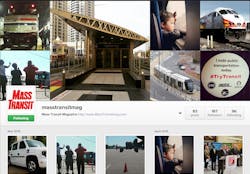Attempting to Keep Up
Reading this month’s story of "New Ways to Attract New Riders," page 28, prompted me to revisit my Instagram account, which had lain dormant over the past year. As described in the story, MARTA uses Instagram in a variety of ways to build relationships with riders and potential riders, all for a minimal investment. Our editors typically post to Instagram but these pictures also are usually available on Facebook and at MassTransitmag.com, which I use more frequently. While not compelled to add to the daily avalanche of information, I hate to miss anything that may better inform, increase productivity, or in some way improve my daily life. It’s become increasingly difficult to know and understand which technologies to embrace, and which ones will get kicked to the curb as not worth the investment in time and effort.
Who could have predicted that in a few short years transit would need to adapt to Google Transit, Uber, Lyft, Zipcar, bike shares, mobile ticketing, Twitter, Instagram, YouTube, Facebook or LinkedIn. Now you must know not only what these and many other digitally enabled products are, but how they fit into the broader scheme of delivering transit service.
The ever-growing array of options in communications, social interaction, navigation, ITS, fare payments and advertising provide our readers with new-found tools seemingly in an endless stream (although on-rushing rapids might be a more apt term). Now the challenge is bringing all these new tools into operations without increasing costs or adding staff, and getting it right. It seems to be a common theme in our stories — new technology meets old; how to make it all work.
Fortunately, the transit industry — much like publishing — can rely on very old and proven conveyances as the foundation of operations, and bring in new technology in supporting roles. Paper tickets are giving way to electronic payments, and printed news is being augmented by digital delivery, so these are incremental upgrades to our core operations, blended in over time. However, the merge ramp seems to be shortening.
I truly enjoy the barrage of new technology and mastering as much of it as possible. I want that Apple watch. But why, with all these efficient digital tools, isn’t there newfound surplus time in the day? I’ll check Facebook and LinkedIn to see if anyone has the answers.
